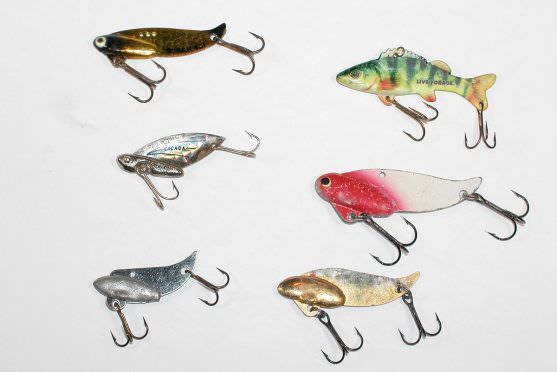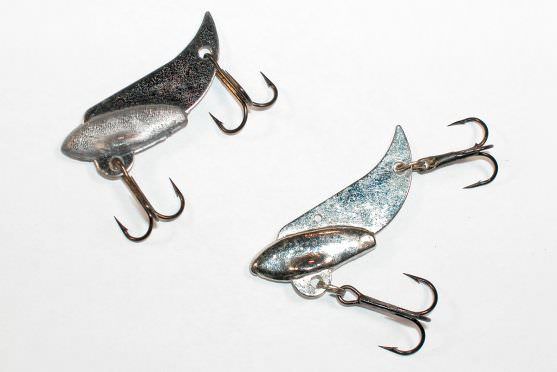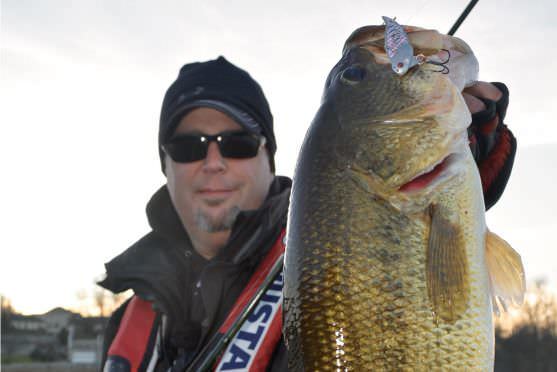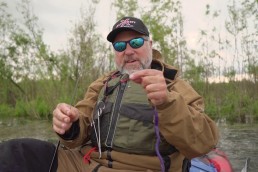Nuances of the Blade Bait
SHARE THIS POST
Fishing a blade bait is simple, but fishing one effectively takes some know-how and practice. Anglers of all skill levels can snap a Silver Buddy or Bullet Blade onto the end of his line, and, if bass, walleyes, pike or crappies are lurking, he has a good chance of catching one.
But there’s a big difference between catching one and having non-stop action on a chilly fall day. And that is when a blade bait comes into its own as a fish-catching machine.
Here are some of the small things you can do to catch a bunch of fish on blades:
Customizing
Most blades come with hooks that can be replaced with much better trebles. The stock hooks usually are pliable trebles with the hook shank split to make them easy to install in the blade’s small holes. Companies do install the hooks by cutting the eyelet, bending it open, poking a cut end through the intended hole on the blade and bending the gap closed. I’ve fished with these stock blades without changing the hooks, and they catch fish, but both kinds of those hooks make me nervous—they probably won’t fail right until I have that really big, hard-fighting smallmouth hooked.

So like a lot of hard-core blade anglers, I replace the stock trebles, adding a premium hook. The shorter-shanked Mustard KVD Treble is my top choice, as not only does the premium hook get embedded in the fish’s mouth better, but the split ring also gives the fish less leverage when it’s fighting back. You definitely will lose fewer fish when you take the time to add good hooks with a split ring.
Favorite blades
Lots of different companies make blade baits; the originals were Heddon Sonars created in the 1950s. I think the standard 1/2-ounce Silver Buddy is hard to beat, and some friends do extremely well on the smaller 1/4-ouncer. Another really good one is the Bullet Blade, which instead of lead uses a zinc alloy for the weight. I like having a few different types, sizes and colors along just in case the fish get picky, but about 90 percent of the time a plain Silver Buddy in their Silver will catch the fish.

Target areas
As fall progresses, the shallows get colder and aquatic plants die providing fewer places for baitfish to hide, the bass’s food moves deeper, and so do the bass. That’s not to say you can’t catch them on shallower flats. Some of the best fishing of the fall happens when wolf packs of bass move up and hunt on expansive flats that still have enough vegetation for bait to relate to. A blade shines here with a long cast and a hopping retrieve that makes the lure vibrate, but not burn too quickly through the fish zone. The objective is to keep the blade north bottom, but not dredging the bottom and picking up weeds in the process.
You can also use a blade at a consistent depth across large flats with a retrieve just fast enough to make it vibrate and stay off the bottom. When you feel resistance it will be either a fish or a weed, and in either case, a sharp jerk of the rod will either set the hook or rip the blade free of the salad. Lots of strikes seem to come right after you rip the lure free and let it settle toward the bottom.
A second place to look for bass with a blade is on sharper drop-offs where weeds are present. Fish tend to hang on the outside edge of the vegetation, and positioning your boat so you can work your lure parallel to the weed bed edge can get your string stretched. Normally, a crankbait would be a better choice, and certainly easier to use, but when the water temperature dip below 50 degrees, bass seem to prefer a blade bait more in direct proportion to how much colder the water gets.
Are you enjoying this post?
You can be among the first to get the latest info on where to go, what to use and how to use it!
When the water gets real cold with surface temperatures below 38 degrees, you can sometimes find bass outside of the weed edges, right in the basin. That’s where the warmest water in the lake will be. The bass aren’t very active, but you can have a pretty good day by positioning your boat in the shallower water, right over the remaining weeds and casting into the basin and moving your bait just fast enough to feel it vibrate a little bit and let it touch the bottom. It’s difficult for many veteran bass anglers to get their heads around this, but bass sometimes inhale a blade when it’s lying right on the bottom. You’ll be working that bottom area, pulling your rod back just fast and far enough to feel the blade “thup-thup-thup.” Let the blade settle, and after it’s assured it’s on the bottom, you’ll feel that “tick.” Other times, the fish will just “be there” when you lift the rod again.
Line
The right kind of line to use depends on the angler; every veteran blade chunker has a favorite and can tell you the reasons why his choice is the best choice. However, not all of them use the same thing. So whatever works for you is the one you should use.
For instance, some guys swear by fluorocarbon for its lower stretch, which transmits the action of the blade instantly and isn’t a factor in keeping line-shy fish from biting. Yet other successful blade fishermen prefer monofilament because it floats more than fluorocarbon does, resulting in a slower fall for the blade down through the water column, serving as a sort of “parachute.” Still other anglers prefer braided line for its super-sensitivity, the fact that it also floats and how well the no-stretch stuff transmits exactly what the blade is doing. Many anglers add a fluorocarbon or mono leader to the end of the braided line to be more confident that fish won’t spook when they see the braid at the lure.

Line visibility is a consideration as well, and the best blade anglers around want a high-vis. line such as Clear Blue Stren or even a golden-colored super-high-vis. line. This, they say, enables them to easily see a fish taking the lure as it sinks, and, they are certain that in the colder water the hi-vis. line does nothing to spook fish.
I personally like fluorocarbon, and just use rods already spooled with it for crankbait fishing earlier in the year. The best suggestion I can offer is to try some different types of line until you find the one that works best for you.
Rod combos
The same holds true for rod combos. Some anglers like rods with all the flexibility of a pool cue, while others prefer a wispy wand. I like a medium-action rod that I use for throwing smaller crankbaits. The rod is sensitive enough to transmit the blade action, has enough backbone to drive the hooks home and is bendy enough to play the fish without tearing the hooks out.
A final note
Always use a snap (not a snap swivel) on the end of your line for attaching the blade. With the way the hole is punched through the metal on these lures, tying any kind of line directly on the blade will result in instantly frayed line and a lost lure.
If you haven’t tried blade bait fishing in fall’s coldwater bodies, give it a shot. It’s a great way to catch numbers of good-sized bass.
Tournament angler and avid outdoorsman, Buck Mallory, of Lawton, Mich., is a regular contributor to MidWest Outdoors, specializing in bass fishing.
MWO
SHARE THIS POST
Did you enjoy this post?
You can be among the first to get the latest info on where to go, what to use and how to use it!
Buck Mallory
Tournament angler and avid outdoorsman Buck Mallory of Lawton writes Michigan-specific bass fishing articles for MidWest Outdoors.



